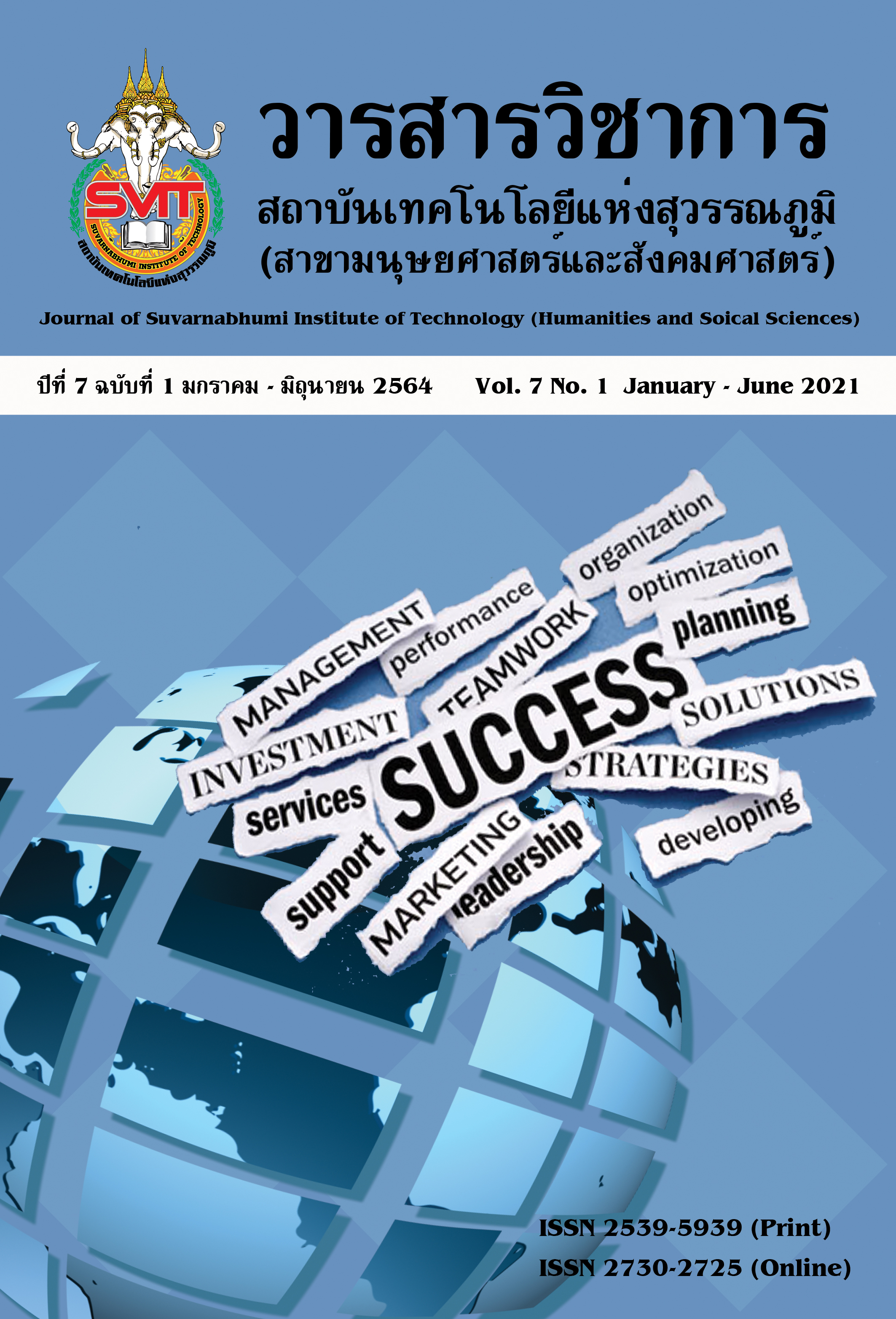THE ROLES OF GOVERNMENT AND CIVIL SOCIETY ON LOCAL COMMUNITY MUSEUM MANAGEMENT: A CASE STUDY OF COMPARATIVE STUDY OF CHINATOWN IN THAILAND AND CHINATOWN IN SINGAPORE
Keywords:
role, government, civil society, local community museum managementAbstract
The purposes of this research was: 1) To study the local community museums management through government and civil society management. 2) To compare the local community museums management between the management by the government and civil society. The sample groups are divided into 5 groups (42 people) which are executive, officer, tourist, people, and shopkeeper. The research instrument is a structured interview and use Analytic Induction for analyzing the data.
It is found from the study that:
- The common point of Tramit Temple Museum in Chinatown, Thailand and Teeth Buddha Temple Asian Museum in Chinatown, Singapore is the area of religion but the exhibits and presentation methods differ according to the purpose. The purpose of Tramit Temple Museum is the migration of overseas Chinese into Siam whereas the purpose of Teeth Buddha Temple Asian Museum is the collection of ancient historical and Mahayana Buddhism artifacts.
- The common points of Historic Hut Charoen Chai Community, Thailand and Chinatown Heritage Museum, Singapore are the setting up and driving by civil society, and focusing on storytelling as much as possible about the way of life and culture which differ according to the amount of space in the exhibit.
- Should use the various technologies and media in the exhibition to increase the interest and learning efficiency combine with the practical activities. Also, should reflect and maintain the local identity through the cooperation and co-consciousness of people in the community.
References
กรมศิลปากร. (2548). คู่มือพิพิธภัณฑ์ท้องถิ่น (พิมพ์ครั้งที่ 2). กรุงเทพฯ: กรมศิลปากร.
กฤษฎา ตัสมา. (2556). การจัดการพิพิธภัณฑ์วัดศรีสุพรรณ อำเภอแม่ใจ จังหวัดพะเยา. สาขาวิชาการจัดการทรัพยากรวัฒนธรรม, บัณฑิตวิทยาลัย มหาวิทยาลัยศิลปากร.
กานต์รวี ชมเชย. (2557). การบริหารจัดการพิพิธภัณฑ์ กรณีศึกษา มิวเซียมสยามและพิพิธภัณฑ์บ้านไทยจิม ทอมป์สัน. สถาบันวัฒนธรรมและศิลปะ, มหาวิทยาลัยศรีนครินทรวิโรฒ.
งามพิศ สัตย์สงวน. (2550). มิติทางวัฒธรรมในการจัดทำพิพิธภัณฑ์ท้องถิ่น. กรุงเทพฯ: สถาบันเทคโนโลยี พระจอมเกล้าเจ้าคุณทหารลาดกระบัง
ชิดหทัย ปุยะติ. (2557). พัฒนาการและลักษณะเด่นของวรรณกรรมจีนโพ้นทะเลในประเทศไทย.
คณะอักษรศาสตร์ ภาควิชาภาษาตะวันออก จุฬาลงกรณ์มหาวิทยาลัย.
โชติมา ยามี. (2556). การบริหารจัดการพิพิธภัณฑ์: ศูนย์ศึกษาวิจัยและพิพิธภัณฑ์ไดโนเสาร์. ขอนแก่น:สำนักงานทรัพยากรธรณี เขต 2 (ขอนแก่น) กรมทรัพยากรธรณี.
ถาวร สิกขโกศล. (2555). เทศกาลจีนและการเซ่นไหว้. กรุงเทพฯ: สำนักพิมพ์มติชน.
พิพิธภัณฑ์มหาวิทยาลัยมหาสารคาม. (2557). ประวัติศาสตร์ท้องถิ่น. มหาสารคาม: พิพิธภัณฑ์มหาวิทยาลัยมหาสารคาม.
ยงยุทธ ชูแว่น. (2551). ประวัติศาสตร์ท้องถิ่นไทย. กรุงเทพฯ: สำนักงานกองทุนสนับสนุนการวิจัย.
วิทย์ บัณฑิตกุล. (2555). สาธารณรัฐสิงคโปร์. กรุงเทพฯ: สถาพรบุ๊ค จำกัด.
ศรีศักร วัลลิโภดม. (2557). ปฏิบัติการประวัติศาสตร์ท้องถิ่น. กรุงเทพฯ: มูลนิธิเล็ก-ประไพ วิริยะพันธุ์.
สายันต์ ไพรชาญจิตร์. (2548). การจัดการโบราณสถาน โบราณวัตถุ ศิลปวัตถุและพิพิธภัณฑ์สถานโดยองค์กรปกครองท้องถิ่น. นนทบุรี: สถาบันพระปกเกล้า.
สำนักงานคณะกรรมการการพัฒนาระบบราชการ [ก.พ.ร.]. (2550). การบริหารงานภาครัฐแบบมีส่วนร่วม. กรุงเทพฯ: สำนักงานคณะกรรมการการพัฒนาระบบราชการ.
สุภางค์ จันทวานิช. (2553). วิธีการวิจัยเชิงคุณภาพ. กรุงเทพฯ: ศูนย์หนังสือจุฬาลงกรณ์มหาวิทยาลัย.
อคิน รพีพัฒน์. (2531). ปัญหาการพัฒนาชนบท บทเรียนจากกรณียกกระบัตร: โครงการพัฒนาชนบท ลุ่มแม่น้ำกรอง. ขอนแก่น: สถาบันวิจัยและพัฒนา มหาวิทยาลัยขอนแก่น.
Douglas A. Allan. (1960). The Organization of museums: practical advice. Paris: United Nations Educational Scientific and Cultural Organization.
International Council of Museums [ICOM]. (2010). Key Concepts of Museology. Paris: Armand Colin.
Stuart Hall. (1993). Culture, community, nation. Cultural Studies, 7(3). 349-363.
Downloads
Published
Issue
Section
License
บทความที่ได้รับการตีพิมพ์เป็นลิขสิทธิ์ของวารสารวิชาการ สถาบันเทคโนโลยีแห่งสุวรรณภูมิ
ข้อความที่ปรากฏในบทความแต่ละเรื่องในวารสารวิชาการเล่มนี้เป็นความคิดเห็นส่วนตัวของผู้เขียนแต่ละท่านไม่เกี่ยวข้องกับสถาบันเทคโนโลยีแห่งสุวรรณภูมิ และคณาจารย์ท่านอื่นๆในสถาบันฯ แต่อย่างใด ความรับผิดชอบองค์ประกอบทั้งหมดของบทความแต่ละเรื่องเป็นของผู้เขียนแต่ละท่าน หากมีความผิดพลาดใดๆ ผู้เขียนแต่ละท่านจะรับผิดชอบบทความของตนเองแต่ผู้เดียว





